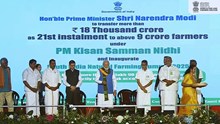
Goat farming is emerging as one of the most profitable and sustainable ventures in India, especially for small and marginal farmers. Recognizing its potential, the Government of India is actively promoting goat farming through the National Livestock Mission (NLM) by offering attractive capital subsidies, technical support, and easy financing.
Here’s everything you need to know about the government support available for goat farming—covering eligibility, benefits, and how to apply.
What is the Government Subsidy for Goat Farmers?
Under the Entrepreneurship Development Programme (EDP) component of the National Livestock Mission, the government provides 50% capital subsidy to entrepreneurs interested in setting up goat breeding farms. This financial support is a game-changer for rural youth, women, farmer groups, and small businesses aiming to enter the livestock sector.
Subsidy Structure
The subsidy is designed to support breeding farms that maintain a specific number of goats. Here's the breakdown:
|
Unit Size (Females + Males) |
Maximum Subsidy |
|
100 + 5 |
Rs 10 lakhs |
|
200 + 10 |
Rs 20 lakhs |
|
300 + 15 |
Rs 30 lakhs |
|
400 + 20 |
Rs 40 lakhs |
|
500 + 25 |
Rs 50 lakhs |
These units can be scaled based on the entrepreneur's capacity, and the subsidy amount increases proportionally.
Who Can Apply?
A wide range of individuals and organizations are eligible for this scheme:
-
Individual farmers or entrepreneurs
-
Farmer Producer Organizations (FPOs)
-
Self-Help Groups (SHGs)
-
Joint Liability Groups (JLGs)
-
Farmer Cooperative Organizations (FCOs)
-
Section 8 Companies
Whether you're a first-time farmer or an existing livestock entrepreneur, if you have land and a solid plan, you can benefit from this initiative.
Eligibility Criteria
To qualify for the scheme, applicants must fulfill the following conditions:
-
Set up a minimum unit of 100 female goats and 5 males
-
Submit a Detailed Project Report (DPR)
-
Provide land documents (ownership or lease)
-
Submit identity proof and bank account details
-
Attach training certificates or proof of experience in goat farming
-
Share photographs of the site and applicant
Application Process – Step-by-Step
-
Visit the NLM Portal: Go to https://nlm.udyamimitra.in and register yourself.
-
Submit Documents: Upload the required documents and DPR for the goat farming unit.
-
State Evaluation: The State Implementing Agency (SIA) will evaluate your proposal.
-
Loan Sanction: After approval, the project is forwarded to the bank for loan processing.
-
Subsidy Release: Once the loan is sanctioned and the project begins, subsidy is released in phases based on implementation milestones.
Impact on Farmers
This scheme has already made a significant impact. For example, in Uttar Pradesh, 145 goat and sheep farming projects were approved, generating employment for over 840 people and benefiting nearly 6,000 farmers. Similar success stories are emerging from other states like Haryana as well.
Why Goat Farming?
Goats are hardy animals that adapt well to Indian climates. They require relatively low investment and provide returns through meat, milk, manure, and even skin. With proper management, goat farming can become a reliable year-round source of income.
Goats are also efficient in converting feed into high-quality products, making them a sustainable choice for farmers. With the right management practices and access to government support, goat farming can offer financial security and become a consistent income source for small and marginal farmers.
With financial help from the government, clear guidelines, and an organized process, goat farming has never been more accessible. Whether you're a young entrepreneur, a progressive farmer, or part of a cooperative, this is the perfect time to explore goat farming.
For more information, applicants are encouraged to visit the official NLM portal or contact the relevant authorities for guidance.

















